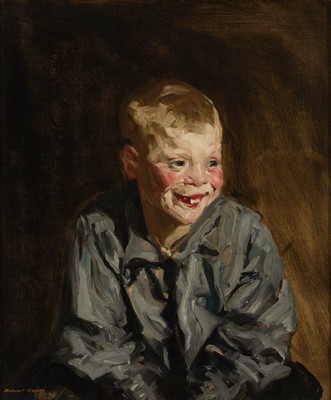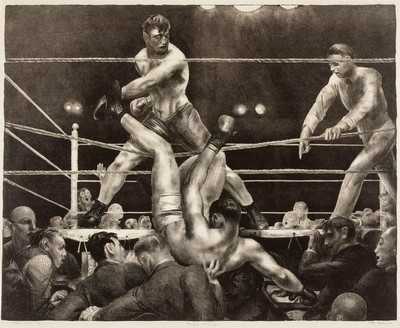The Ashcan School and The Eight: “Creating a National Art”
Milwaukee Art Museum
September 23, 2022 - February 19, 2023
Dutch Joe (Jopie van Slooten), 1910
Oil on canvas
Gift of the Samuel O. Buckner Collection M1919.9
Photo by John R, Glembin
Courtesy of the Milwaukee Art Museum
Dempsey and Firpo , 1923–24
Lithograph
Gift of Philip Pinsof M1956.28
Photo by John R. Glembin
Courtesy of the Milwaukee Art Museum
Rhythms , ca. 1910
Oil on canvas
Gift of Mr. and Mrs.Donald B. Abert in memory of Harry J.Grant M1966.57
Photo by John R. Glembin
Courtesy of the Milwaukee Art Museum
The Milwaukee Art Museum presents The Ashcan School and The Eight: “Creating a National Art,” a major exhibition exploring the work of the turn-of-the-century Ashcan School and The Eight—widely recognized today as America’s first modern art movement. Mining the Museum’s expansive collection of works by the Ashcan School, The Eight, and affiliated artists—one of the largest and most significant collections of these works in the United States—the exhibition examines these artists’ rejection of traditional art practices and institutions and the impact of this subversion on the trajectory of American modern art. Recontextualizing the pieces in this collection, the show also draws connections between the social issues depicted in these works and those still prevalent in the U.S. today.
So named for their first major exhibition in 1908 at New York City’s Macbeth Gallery, Eight American Painters, The Eight is comprised of artists Robert Henri, Arthur Bowen Davies, William Glackens, Ernest Lawson, George Luks, Maurice Prendergast, Everett Shinn, and John Sloan, all of whom embraced new modes of artistic representation and eschewed exhibition practices that they considered restrictive and conservative. Often embracing a loose painterly style to portray subjects previously deemed inappropriate for high art and museums, these artists—who one critic lionized as “creating a national art,” while another later disparaged as painters of “ashcans,” unwittingly giving them the name by which they would become commonly known—captured the realities of everyday life in the American city at a moment of great transformation: early in their careers, they frequently depicted scenes of immigrants, tenements, urban spaces, and shifting cultural dynamics, social values, and identities. Featuring nearly 150 paintings, drawings, pastels, and prints, The Ashcan School and The Eight presents both iconic and rarely seen pieces by these artists, demonstrating the breadth of their practices and the continued relevance of their work in examining and reflecting the reality of urban America’s working class.
“The Ashcan School and The Eight: ’Creating a National Art,’ is an opportunity to engage new audiences with key works from our esteemed collection that are emblematic of the seismic shift in the ethos of this contingent of American artists who were working at the turn of the 20th century,” said Brandon Ruud, exhibition curator and former Abert Family Curator of American Art at the Milwaukee Art Museum. “Their break from longstanding tradition to instead portray a more authentic depiction of the American experience forged a new national art that prioritized an unfiltered representation of urban and working-class life and catalyzed the evolution of American modern art in the process.”
The Ashcan School and The Eight: “Creating a National Art” builds on the Milwaukee Art Museum’s leadership in the presentation and collection of Ashcan School works of art. Since the early 1900s, the Museum has stewarded works from the Ashcan School, leading up to a transformative gift from the Abert Family, Milwaukee philanthropists who purchased nearly 50 works across media by the Ashcan School and The Eight for the express purpose of donating to and expanding this portion of the Museum’s collection. The Ashcan School and The Eight: “Creating a National Art” advances the Milwaukee Art Museum’s commitment to developing scholarly discourse around these artists’ revolutionary practices, presenting these radical works to new generations of museumgoers, and creating connections across American modern and contemporary history.
Among the notable works featured in the exhibition are:
- Robert Henri’s Dutch Joe (Jopie van Slouten) from 1910, the first Ashcan painting to enter the Museum’s collection.
- Robert Henri’s The Art Student and El Matador (both 1906), pivotal paintings that started the trajectory of the artist’s career and contributed to the group’s break with the National Academy of Design.
- Arthur Bowen Davies’s Rhythms (ca. 1910), George Benjamin Luks’s Bleecker and Carmine Streets, New York (ca. 1905), and Robert Henri’s Chinese Lady (1914), all paintings from the Abert Collection.
- John Sloan’s Isadora Duncan (1911), a painting that epitomizes the Ashcan School’s interest in performance and theater.
- Stuart Davis’s Tenement Scene (1912), an early, rare painting inspired by Davis’s initial study with Robert Henri.
“We are thrilled to welcome visitors from our Milwaukee community and beyond to explore the Museum’s unparalleled collection of works by artists of the Ashcan School and The Eight,” stated Marcelle Polednik, Donna and Donald Baumgartner Director of the Milwaukee Art Museum. “Five decades ago, the Abert family purchased nearly 50 works by members of the Ashcan School for the Museum’s collection, enabling us to tell the rich story of these important artists and their contributions to the field. This exhibition is an exciting opportunity to revisit these works and others that we have acquired in the years since, and to present them in new ways that both educate and inspire our audiences, while also celebrating the Abert family’s exemplary gift to the Museum.”
The Ashcan School and The Eight: “Creating a National Art” is accompanied by a 172-page catalog with over 200 color illustrations, thematic essays, and an illustrated checklist of the Museum’s entire Ashcan collection. This publication not only indexes these works but also activates them as a catalyst for new scholarship by a team of noted experts, who explore the contexts and concerns that shaped American modernism at the beginning of the 20th century. Contributors and essayists include Brandon Ruud, Abert Family Curator of American Art at the Milwaukee Art Museum; John Fagg, Senior Lecturer in American Literature and Cultures at the University of Birmingham, England; Margarita Karasoulas, Curator of Art at the Bruce Museum in Greenwich, Connecticut; and Nikki Otten, Associate Curator of Prints and Drawings at the Milwaukee Art Museum; with a foreword by the Museum’s director, Marcelle Polednik, PhD.
MILWAUKEE ART MUSEUM
700 N. Art Museum Drive, Milwaukee, WI 53202



